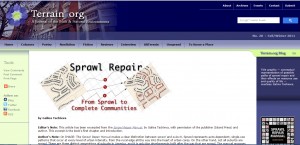Sprawl is a pattern of growth characterized by an abundance of congested highways, strip shopping centers, big boxes, office parks, and gated cul-de-sac subdivisions—all separated from each other in isolated, single-use pods. This land-use pattern is typically found in suburban areas, but also affects our cities, and is central to our wasteful use of water, energy, land, and time spent in traffic. Sprawl has been linked to increased air and water pollution, greenhouse gas emissions, loss of open space and natural habitat, and the exponential increase in new infrastructure costs. Social problems related to the lack of diversity have been attributed to sprawl, and health problems such as obesity to its auto-dependence.
In contrast, complete communities have a mix of uses and are walkable, with many of a person’s daily need—shops, offices, transit, civic and recreational places—within a short distance of home. They are compact, so they consume less open space and enable multiple modes of transportation, including bicycles, cars, and mass transit. A wide variety of building types provides options to residents and businesses, encouraging diversity in population. This mix of uses, public spaces, transportation, and population makes complete communities economically, socially, and environmentally sustainable.
Sprawl Repair – From Sprawl to Complete Communities
